Communications of the ACM
Forced Labor at Bührle's Arms Factory

There was forced labor at Spinnerei & Weberei Dietfurt AG, Bütschwil, in the 1950s and 1960s. This is revealed by Swiss media reports (Beobachter of August 26, 2021, Tages-Anzeiger of August 27, 2021, St. Galler Tagblatt of March 29, 2022). From 1941, the factory and the attached girls' home belonged to the industrialist Emil Bührle, who was active as an arms manufacturer and art collector. Swiss welfare offices apparently assigned hundreds of underage girls to the Marienheim run by the Ingenbohl sisters. The very poorly paid work of the supposedly difficult-to-educate youths began as early as five o'clock.
Several Bührle companies played an important role in the history of information technology: the Spinnerei & Weberei Dietfurt, Contraves AG, Zurich, and Werkzeugmaschinenfabrik Oerlikon, Bührle. Whether forced labor also occurred in other companies? It has only been known since 2011 that the textile company used an electro-mechanical calculating punch M9 built by the German Zuse KG, Neukirchen, from 1956 to 1968 (see Fig. 1). The punched card machine used in Toggenburg has not been preserved. Of the 30 or so Zuse calculating punches that were manufactured, only one has survived. It is located in the Museum für Kommunikation, Bern. The M9 is considered to be the first mass-produced program-controlled computing machine on the European mainland.
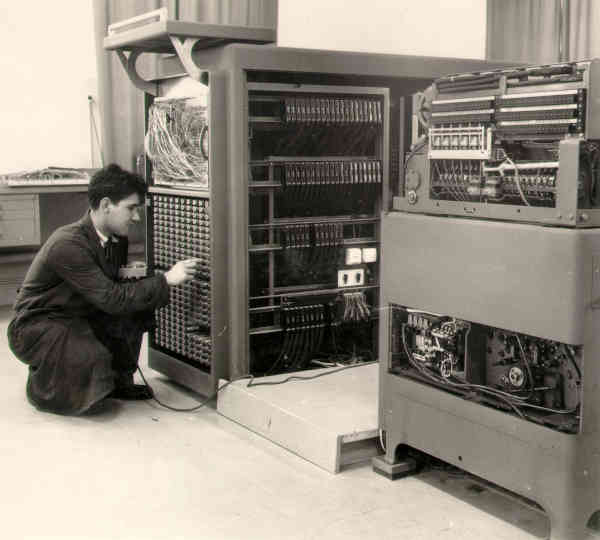
Max Forrer, head of the computer center of the Spinnerei & Weberei Dietfurt SG,
is seen working on the relay cabinet (arithmetic unit) of the M9.
At right is the open sensing and punching unit.
Credit: Max Forrer, Oberhelfenschwil SG
The M9 was used in Toggenburg for a wide range of tasks: Bookkeeping (payroll, accounting for social insurance, invoicing, delivery bills, sales statistics), stock management (see Fig. 2), and also for the municipal administration of Bütschwil. Max Forrer wrote about 1,000 programs for the M9 and the corresponding punched card machines, which were stored on punched cards. There were 50 to 100 punched cards per program. It was a matter of determining, for example, the efficiency, the downtime, and the duration of the loom preparation. For payroll accounting, cards were used for, among other things, attendance time, shift allowance, cost-of-living allowance, gross wage, overtime allowance, housekeeping allowance, child allowance, vacation, and seniority allowance. In general, the M9 was not programmed by the users, but by the maintenance technicians (of Remington Rand, Zurich).
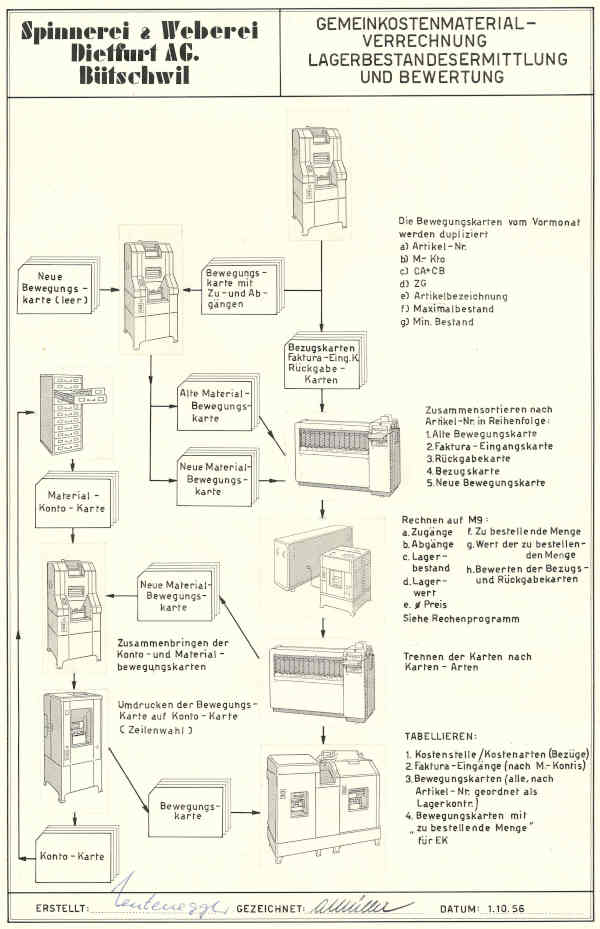
The M9 (right column, third machine group from below) functioned with different types
of punched card equipment: duplicating punch, collator, sorter, and tabulator.
Handwritten original workflow chart of October 1, 1956.
Credit: Max Forrer, Oberhelfenschwil SG
Contraves, Zürich
Zurich-based Contraves (now Rheinmetall Air Defence AG) played an important role in the procurement of the Zuse Z4 electromechanical relay computer in 1949. Its director, Hans Brändli, and technical director, Max Lattmann, acted as consultants to the Institute of Applied Mathematics at ETH Zurich and supported the lease of the machine. The Z4 was in operation in Zurich from 1950 to 1955. It was used, among other things, for calculations of the Grande Dixence dam and the P-16 jet aircraft built in Altenrhein on Lake Constance. In 1950, there were only two functioning computers in Continental Europe, the tape-controlled Z4 and the plugboard controlled Bark (Stockholm). In this context, a forgery occurred at the publishing house Neue Zürcher Zeitung. The work "Ingenieure bauen die Schweiz. Technikgeschichte aus erster Hand" (see Fig. 3) contains alleged memoirs by Max Lattmann. However, they were written by Jürg Lindecker, see (PDF) Technikgeschichte: Fälschungsskandal bei der Neuen Zürcher Zeitung (NZZ) (researchgate.net), http://dx.doi.org/10.13140/RG.2.2.24665.39524/1.
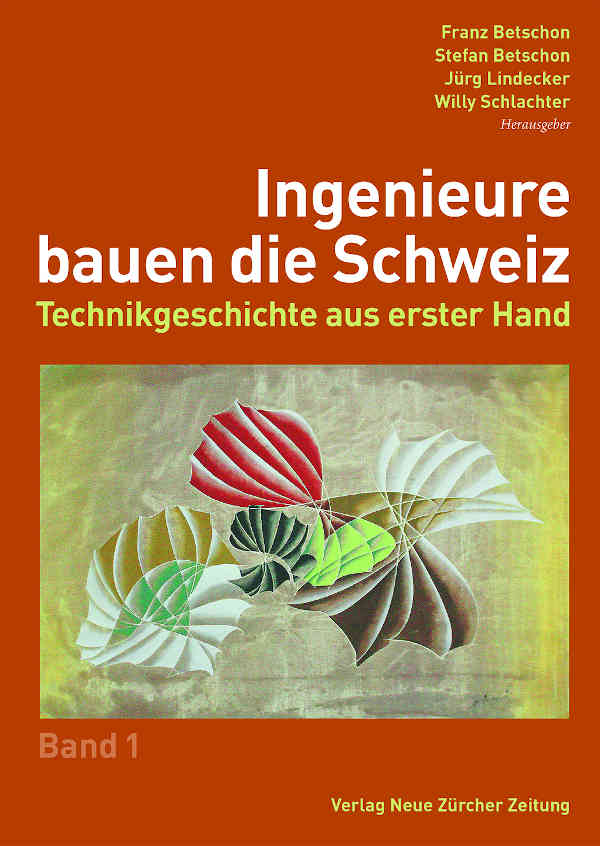
The Zuse Z4 built in 1945 has been preserved. It is in the Deutsches Museum in Munich (see Fig. 4).
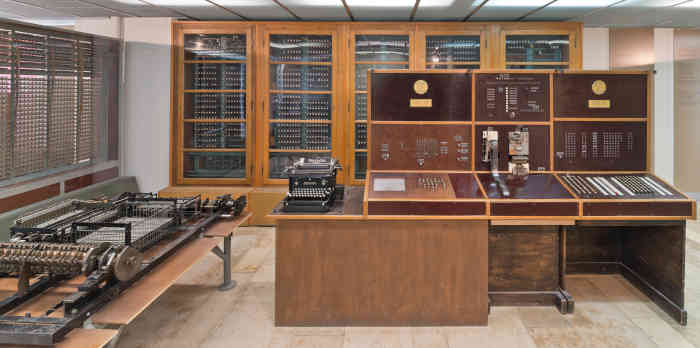
was in operation at ETH Zurich from 1950 to 1955. The relay machine is no longer functional.
It is regarded as the oldest surviving programmable, and the first commercially available, computer.
Credit: Deutsches Museum, Munich
In the 1950s, Contraves manufactured the IA55 and IA58 electromechanical differential analyzers (analog computers). A competitor was Amsler & Co. in Schaffhausen. The first transistor computer manufactured in Switzerland, the Cora, was created at Contraves. It was ready in 1963. Until November 2011, even the experts knew nothing about this machine. About 60 specimens of the Cora were produced. The only surviving example is in the Musée Bolo of the Swiss Federal Institute of Technology (EPFL) in Lausanne (see Fig. 5). The most important industrial application was the control of high-precision plotters.
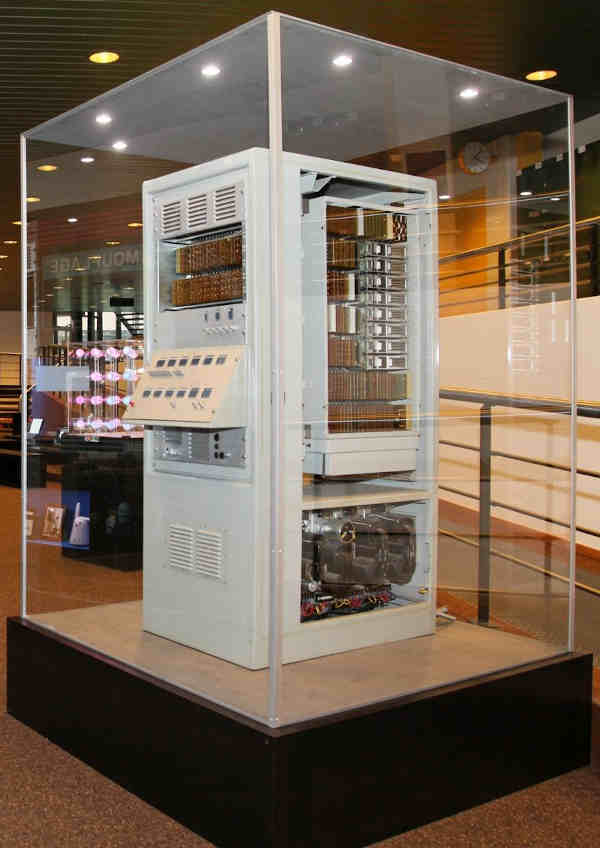
The first Swiss transistor computer, built in Zurich, was only recently rediscovered.
It is on display in the Musée Bolo at the Swiss Federal Institute of Technology in Lausanne.
Credit: EPFL, Alain Herzog
Werkzeugmaschinenfabrik Oerlikon, Bührle
In the 1950s, the Werkzeugmaschinenfabrik Oerlikon, Bührle manufactured several electromechanical calculating machines called the Ultra. Features of this machine, which masters all four basic arithmetic operations, are the ten-key keypad and the printing unit (see Fig. 6).
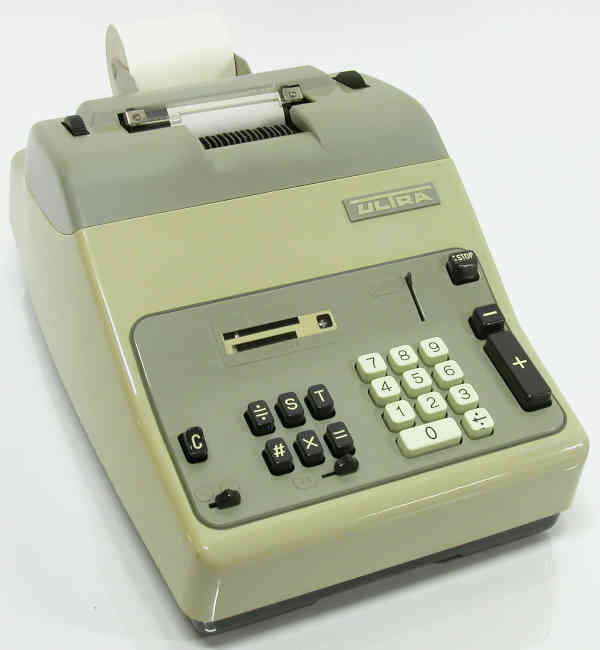
featuring a ten-key keyboard and printing mechanism.
Credit: Museum für Kommunikation, Bern
References
Bolognini, Yves; Stamm, Marielle (Hg.): Disparition programmée. Le musée Bolo mène l'enquête. Programmed disappearance. The Bolo museum investigates, Presses polytechniques et universitaires romandes, Lausanne 2013, 199 Seiten
Bruderer, Herbert: Meilensteine der Rechentechnik, De Gruyter Oldenbourg, Berlin/Boston, 3. Auflage 2020, Band 1, 970 Seiten, 577 Abbildungen, 114 Tabellen, https://www.degruyter.com/view/title/567028?rskey=xoRERF&result=7
Bruderer, Herbert: Meilensteine der Rechentechnik, De Gruyter Oldenbourg, Berlin/Boston, 3. Auflage 2020, Band 2, 1055 Seiten, 138 Abbildungen, 37 Tabellen, https://www.degruyter.com/view/title/567221?rskey=A8Y4Gb&result=4
Bruderer, Herbert: Milestones in Analog and Digital Computing, Springer Nature Switzerland AG, Cham, 3rd edition 2020, 2 volumes, 2113 pages, 715 illustrations, 151 tables, translated from the German by John McMinn, https://www.springer.com/de/book/9783030409739
Bruderer, Herbert: Konrad Zuse und die Schweiz. Wer hat den Computer erfunden?, de Gruyter Oldenbourg-Verlag, München 2012, XXVI, 224 Seiten
de Beauclair, Wilfried: Rechnen mit Maschinen. Eine Bildgeschichte der Rechentechnik, Springer-Verlag, Berlin, Heidelberg, 2. Auflage 2005, XII, 313 Seiten
Inauen, Ernst: Relaisrechner mit Lochstreifeneingabe und -ausgabe, Diplom-Arbeit, Sommer 1962, Abendtechnikum Zürich (Hochschule für Technik Zürich), 64 Seiten, 13 Abbildungen (A4), http://dx.doi.org/10.3929/ethz-a-006495462 (Veröffentlichung 2011)
Mußtopf, Günter (Hg.): Als die Computer Laufen lernten. Ein amüsanter Rückblick, perComp Verlag, Hamburg 2005, VIII, 180 Seiten (Beitrag von Alarich Baeumler: Mein Weg zum Computerentwickler)
Zuse, Konrad: Der Computer – Mein Lebenswerk. Mit Geleitworten von Friedrich L. Bauer und Heinz Zemanek, Springer-Verlag, Berlin, Heidelberg, 5., unveränderte Auflage 2010, XV, 218 Seiten (Zuses Lebenserinnerungen) (Erstausgabe Verlag Moderne Industrie Wolfgang Dummer & Co., München 1970)
Herbert Bruderer ([email protected]; [email protected]) is a retired lecturer in the Department of Computer Science at ETH Zurich and a historian of technology.
No entries found